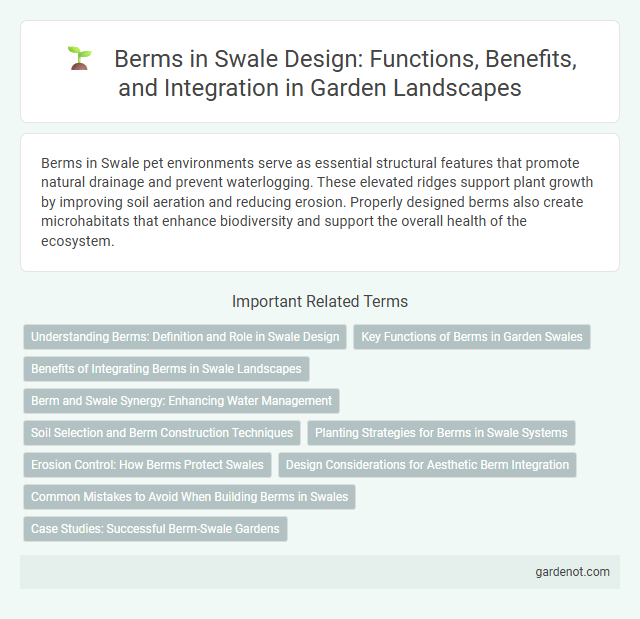Berms in Swale pet environments serve as essential structural features that promote natural drainage and prevent waterlogging. These elevated ridges support plant growth by improving soil aeration and reducing erosion. Properly designed berms also create microhabitats that enhance biodiversity and support the overall health of the ecosystem.
Understanding Berms: Definition and Role in Swale Design
Berms are raised barriers or embankments constructed alongside swales to direct surface water flow and prevent erosion. Their strategic placement enhances swale functionality by controlling runoff velocity and promoting water infiltration into the soil. Effective berm design is crucial for maintaining swale stability and optimizing stormwater management in landscape architecture.
Key Functions of Berms in Garden Swales
Berms in garden swales play a crucial role in water management by directing runoff and enhancing infiltration into the soil. They help prevent erosion by stabilizing slopes and slowing water flow, which promotes moisture retention and supports plant growth. Strategically placed berms increase the swale's efficiency in capturing and distributing water across the landscape.
Benefits of Integrating Berms in Swale Landscapes
Integrating berms in swale landscapes enhances water management by directing runoff flow, reducing erosion, and increasing infiltration rates. Berms create natural barriers that promote sediment deposition and improve soil moisture retention, supporting vegetation growth and biodiversity. These raised earth structures contribute to landscape stability and aesthetic appeal while boosting the swale's overall ecological function.
Berm and Swale Synergy: Enhancing Water Management
Berms adjacent to swales create a natural barrier that directs stormwater flow and enhances infiltration, reducing surface runoff and promoting groundwater recharge. The synergy between berms and swales optimizes water retention by slowing down water movement, which minimizes erosion and improves sediment capture. This combined approach supports sustainable landscape drainage and mitigates flooding risks in urban and agricultural settings.
Soil Selection and Berm Construction Techniques
Selecting well-draining, cohesive soil such as sandy loam or clay loam ensures berm stability and effective water retention in swale applications. Berm construction techniques involve compacting soil in layers, shaping the berm to direct runoff efficiently while preventing erosion through vegetation or mulch cover. Proper soil selection combined with precise layering enhances the berm's structural integrity and longevity in landscape water management.
Planting Strategies for Berms in Swale Systems
Planting strategies for berms in swale systems prioritize native, drought-tolerant vegetation with deep root systems to enhance soil stability and water infiltration. Incorporating a diverse mix of grasses, shrubs, and perennials helps filter pollutants and supports local biodiversity. Proper plant selection reduces erosion on berm slopes while optimizing the swale's stormwater management efficiency.
Erosion Control: How Berms Protect Swales
Berms are essential for erosion control in swales by stabilizing soil and reducing surface runoff velocity. These raised barriers redirect water flow, minimizing soil displacement and preventing channel erosion within the swale system. Properly designed berms enhance swale efficiency by maintaining vegetation integrity and improving water infiltration.
Design Considerations for Aesthetic Berm Integration
Design considerations for aesthetic berm integration in swales emphasize the use of native vegetation and naturalistic shapes to blend seamlessly with the surrounding landscape. Berms should be strategically located to enhance water flow management while offering visual appeal through varied heights and gentle slopes. Incorporating textured surfaces and complementary plant species promotes biodiversity and creates an inviting, functional green space.
Common Mistakes to Avoid When Building Berms in Swales
Common mistakes when building berms in swales include improper grading that disrupts natural water flow and causes erosion, using unsuitable soil types that reduce stability, and failing to compact the soil adequately, leading to structural failure. Neglecting to incorporate vegetation on berms can increase runoff and sediment displacement. Ensuring correct slope, soil selection, and plant integration is essential for maintaining berm effectiveness in water management.
Case Studies: Successful Berm-Swale Gardens
Berm-swale gardens have demonstrated exceptional stormwater management and soil erosion control in urban landscaping projects across various regions. Case studies reveal that strategically designed berms, combined with swales, not only enhance water infiltration but also support native vegetation growth, improving biodiversity and reducing runoff velocity. Successful implementations, such as those in Portland and Melbourne, show significant improvements in groundwater recharge and flood mitigation, making berm-swale systems vital for sustainable urban development.
Berms Infographic

 gardenot.com
gardenot.com